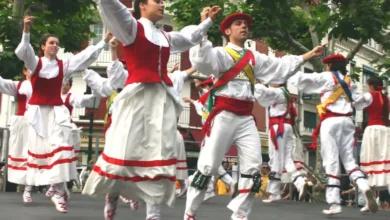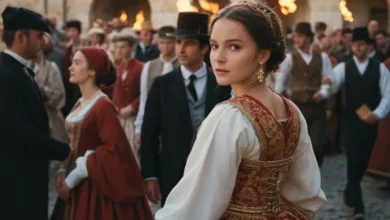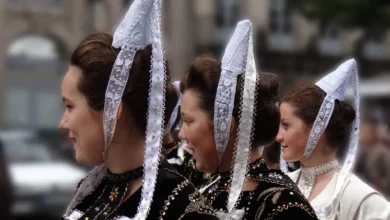Hey there, friend. Imagine a gentle sea breeze lifting the edges of intricate white lace, framing faces lit with quiet determination. That’s the essence of coiffes bretonnes—those iconic Breton headdresses that turn heads and tell tales. If you’ve wandered Breton festivals or flipped through vintage photos, you’ve felt their pull: elegant, enduring symbols of a culture that refuses to fade.
In this article, we’ll lace up the history, tease out the designs, and peek at how they’re blooming anew in 2025. Whether you’re a heritage hunter, a style seeker, or just drawn to stories stitched in silk, join me. You’ll step away ready to celebrate your own roots with a touch of grace.
Outfits like coiffes bretonnes aren’t mere accessories—they’re anchors. They ground us in place, purpose, and people. Let’s weave through this Breton beauty together.
The Roots of Coiffes Bretonnes: From Everyday Cover to Cultural Emblem
Envision 17th-century Brittany, a rugged peninsula where Celtic whispers mingle with salty winds. Women there needed head coverings for sun, wind, and work, but coiffes bretonnes evolved into far more: badges of identity in a world demanding conformity. Legends swirl around their birth—some say Bigouden women raised their lace towers in defiance of Louis XIV’s taxes and church steeple choppings, a silent “we rise above.” By the 18th century, these headdresses dotted rural life, varying by parish like dialects in the Breton tongue.
See also Discovering the Elegance of Traditional Clothing in France
Discovering the Elegance of Traditional Clothing in France
It wasn’t elite fashion; it was peasant power. As France industrialized, Bretons clung to these pieces amid urbanization’s pull. Over 400 styles emerged, each a map to a village’s soul—practical for fields, pious for pardons (religious festivals). Academics like Jean-Pierre Gonidec in Coiffes et Costumes des Bretons (2013) trace their arc from utility to unity, noting how they mirrored societal shifts.
From a Native Breton view, they’re lifelines. One elder from Pont-l’Abbé shares in a cultural oral history: “My grandmother’s coiffe wasn’t just lace—it held our stories, our storms, our saints. Wearing it meant we belonged, no matter the king’s decrees.” The Institut de Bretagne echoes this, calling them “threads of resilience” in regional archives.
Intriguing note: The term “coiffe” might hail from Latin coffia (cap), blending with Breton krib (crest)—a nod to their proud perch.
A Timeline of Coiffes Bretonnes‘ Rise and Renewal
For easy scanning, here’s how these lace icons unfolded:
See also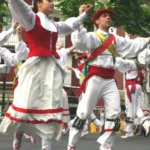 Traditional Clothing in France: Basque Costume
Traditional Clothing in France: Basque Costume
| Year/Period | Key Milestone |
|---|---|
| 17th Century | Emergence as basic linen covers; legends tie to tax revolts against Louis XIV. |
| 1747 | First distinct mention of Pont-l’Abbé style in records, marking regional divergence. |
| Early 1800s | Industrial textiles boost embroidery; Bigouden coiffe starts low (5-10 cm), grows with factory rivalries. |
| 1843 | Artist F.H. Lalaisse sketches detailed designs, sparking national curiosity. |
| 1920s-1960s | Peak height (30-40 cm in Penmarc’h); daily wear for thousands, symbol of post-WWI pride. |
| 1950s | Decline begins with urbanization; becomes caricature cliché in French media. |
| 1977 | 3,567 women wear daily (31% over 47); cultural revival kicks in with tourism. |
| 1993 | Only 500 wearers left; shifts to festivals. |
| 2006 | Association Ijin ha Spered ar Vro forms to revive filet-brocart techniques. |
| 2025 | Modern twists in fashion shows; UNESCO push for intangible heritage status. |
This path shows adaptation: from survival gear to stage star.
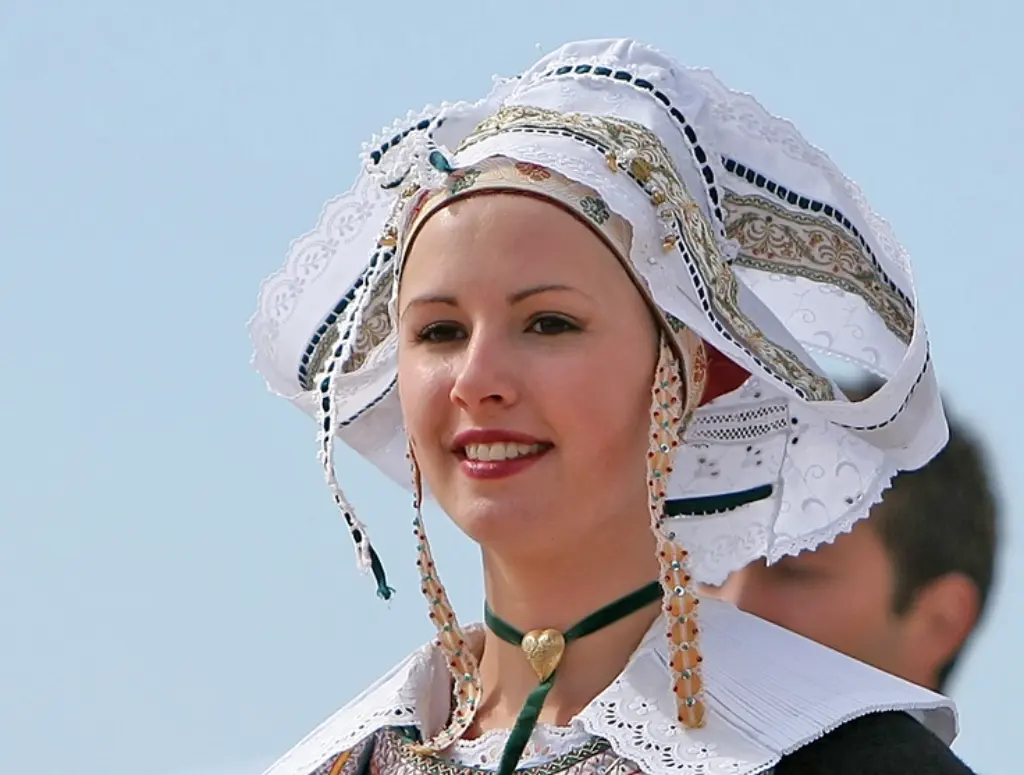
Decoding the Design: What Makes Coiffes Bretonnes So Enchanting?
At heart, a coiffe bretonne is lace poetry—light as mist, structured as stone. Crafted by hand in winter evenings, each demands 100+ hours of skill. Over 100 variants exist, but core parts unite them: a base for the bun, wings for flair, and endless embroidery whispering local lore.
Core Elements at a Glance
- Fond (Base): Soft linen or cotton canvas, shaped over a chignon; anchors the whole.
- Visagière (Face Framing): Delicate band hugging brows, often embroidered with geometrics or florals symbolizing faith or fertility.
- Ailes (Wings): Side flaps—short and stiff in Léon, long and flowing in Cornouaille; folded or knotted to signal status.
- Bavolet (Neck Guard): Rear panel, varying from tiny to trailing; protects from drafts, adds silhouette drama.
- Dentelle and Broderie (Lace & Embroidery): White filet noué (knotted mesh) base, adorned with motifs—roses for love, crosses for piety. Black ribbons denote mourning.
Materials? Local linens starched with wheat paste for hold; silks for shine in ceremonies. A 2023 study in Textile History lauds their ergonomics: breathable for labor, adjustable for life stages. Native makers affirm: “It’s not worn—it’s balanced, like the tides we live by,” says a Quimper artisan.
Style secret: Pair with a simple bun—let the lace lead.
Cultural Significance: Coiffes Bretonnes as Brittany’s Silent Storytellers
These headdresses aren’t fluff; they’re Breton DNA. Worn from communion to grave, they marked milestones: white for brides, black-trimmed for widows. In a region of fierce independence, coiffes bretonnes signaled “I’m from here”—village by village, a code for community and class.
Layers of Meaning in the Lace
- Identity Markers: A Fouesnant wing’s curve vs. a Bigouden tower—5 km apart, worlds different. They fostered pride amid French assimilation.
- Social Signals: Height or trim denoted marital status, wealth; embroidery hid messages of resilience.
- Economic Engines: Lacework sustained families, especially in coastal factories—women’s quiet revolution.
Breton voices deepen this: In Bretonnes (2016), photographer Charles Fréger captures elders saying, “The coiffe held our secrets—love letters in stitches, prayers in pleats.” Gonidec’s work highlights their role in Celtic revival, countering 20th-century “modernization” that nearly erased them. Yet stereotypes linger—the Bigouden as “quaint”—but locals reclaim: “It’s our crown, not a cartoon.”
Coiffes Bretonnes in Popular Culture: From Pardons to Paris Runways
These lace wonders light up Breton lore and beyond. At pardons like Sainte-Anne-d’Auray, seas of white wings sway in procession—living art. Artists from Lalaisse to modern lensman Fréger immortalized them, turning fields into frames.
Iconic Spotlights and Modern Echoes
- Festival Queens: At Festival de Cornouaille, dancers don variants—Bigouden towers towering in torchlight.
- Celeb Charms: Singer Nolwenn Leroy sports slimmed Fouesnant styles at gigs, blending folk with pop.
- Global Glimpses: Exported to U.S. via Kennedy-era dolls; now in NYC exhibits as “feminist filigree.”
- Screen Sirens: Featured in films like Chouans! (1988), evoking revolutionary spirit.
They empower: From caricature to couture, coiffes bretonnes rewrite narratives.
For more Celtic flair, explore our Breton pardon guide or Celtic embroidery basics.
2025 Revivals: Coiffes Bretonnes in Fresh, Forward Fashion
Flash to October 2025: Coiffes bretonnes aren’t museum relics—they’re runway rebels. Eco-lace from recycled linens nods to sustainability, while Lorient lycéennes remix ’50s styles for Gouel Breizh défilés.
Innovative Twists for Today
- Eco-Edits: Organic cottons, natural dyes—Husfliden-inspired ateliers cut waste.
- Youthful Yields: Shorter wings, neon threads for festivals; queer collectives add rainbow motifs.
- Hybrid Heirlooms: Fused with streetwear—coiffe caps over hoodies for urban Bretons.
Native innovators thrive: “We’re not preserving—we’re progressing,” beams a Pont-l’Abbé designer. Fashion Practice (2024) dubs this “heritage hacking.”
How to Wear Coiffes Bretonnes: Your Gentle Guide
Eager to try? Start simple—respect roots, add flair. It’s about poise, not perfection.
Step-by-Step Styling Tips
- Select Your Style: Match heritage—Bigouden for bold, Léon for subtle. Beginners: Rent from museums (~€20/day).
- Prep the Base: Slick bun with pins; mist with starch for hold. No flyaways—clean lines rule.
- Assemble Artfully: Secure fond, fan wings, tie bavolet. Add ribbons for occasions—red for joy, black for solemn.
- Occasion Matches:
- Pardon/Festival: Full lace, embroidered apron—pair with clogs for dance.
- Wedding: Heirloom height, floral accents; soft shawl below.
- Casual: Work coiffe (turban-style) with jeans—subtle nod.
Locals advise: “Breathe into it—feel the weight of ancestors, light as air.” Ethical pick: Artisans via Ijin ha Spered.
See our coiffe care handbook for upkeep.
Why Coiffes Bretonnes Still Whisper: Empowerment in Every Wing
From 17th-century fields to 2025 catwalks, coiffes bretonnes endure as Brittany’s lace manifesto. They teach: Evolve without erasing, unite without uniformity. In fast fashion’s blur, they invite mindful making—stories over speed.
Gonidec sums it: “These are not hats; they are histories you wear.” Bretons affirm: Pride in pleats heals divides.
Your Invitation: Crown Yourself with Coiffes Bretonnes
Friend, why wait? Visit Pont-l’Abbé’s Musée Bigouden for a workshop—custom kits from €50, heirlooms for life. Snap your first coiffe at a pardon; share the sparkle. Or gift lace lessons—stitch bonds ethically.
Back Native hands through associations like Ijin ha Spered. Practical: Versatile for vows or vibes. Empowering: When you lift those wings, you lift a legacy.
What’s your cultural crown? Comment below—let’s lace up a conversation. Your heritage awaits. Go wear it well.
